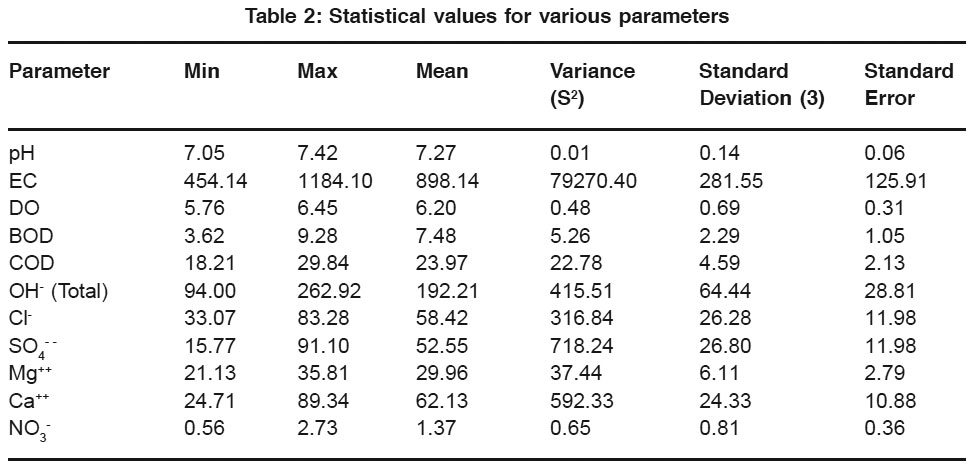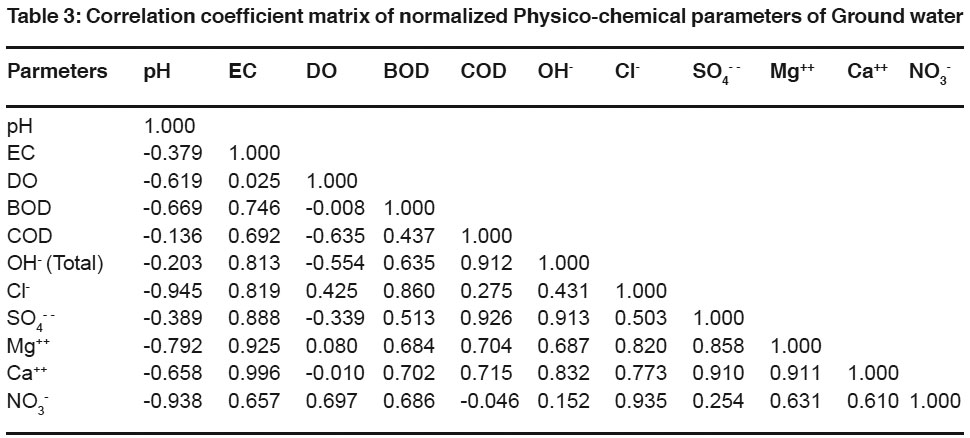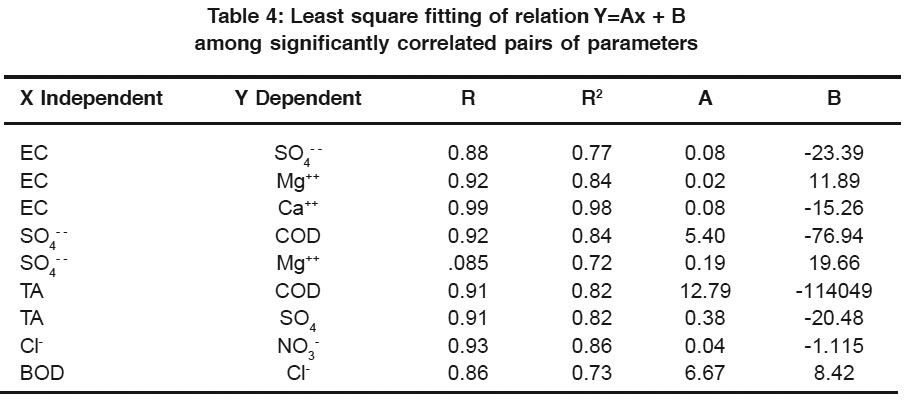A correlation study on physico- chemical characteristics of ground water in Thane-Belapur Industrial area, Mumbai
A.D. Chapolikar1 * and M.B. Ubale2
1
Government College of Arts and Science,
Aurangabad,
India
2
PG. Centre in Chemistry,
Vasantrao Naik Mahavidyalaya,
Aurangabad,
431 003
India
DOI: http://dx.doi.org/10.12944/CWE.5.1.09
The Physico-chemical characteristics of Ground water in Thane-Belapur Industrial Area has been studied to examine its suitability for drinking purpose.the suitability of ground water has been evaluated with reference to Indian standards. A correlation analysis has been carried out among the various parameters. The analysis is very useful in the rapid study of ground water quality. The study revealed that many of Ground water samples in this area were non-potable.
Copy the following to cite this article:
Chapolikar A.D, Ubale M. B. A correlation study on physico- chemical characteristics of ground water in Thane-Belapur Industrial area, Mumbai. Curr World Environ 2010;5(1):67-71 DOI:http://dx.doi.org/10.12944/CWE.5.1.09
Copy the following to cite this URL:
Chapolikar A.D, Ubale M. B. A correlation study on physico- chemical characteristics of ground water in Thane-Belapur Industrial area, Mumbai. Curr World Environ 2010;5(1):67-71. Available from: http://www.cwejournal.org/?p=1102
Download article (pdf)
Citation Manager
Publish History
Select type of program for download
| Endnote EndNote format (Mac & Win) | |
| Reference Manager Ris format (Win only) | |
| Procite Ris format (Win only) | |
| Medlars Format | |
| RefWorks Format RefWorks format (Mac & Win) | |
| BibTex Format BibTex format (Mac & Win) |
Article Publishing History
| Received: | 2009-06-01 |
|---|---|
| Accepted: | 2009-07-05 |
Introduction
Access to safe drinking water is a fundamental human need and therefore, a basic right. Contaminated water jeopardizes both. The physical and social health of all people and it is an affront to human dignity (MNB Momba et. al 2006). Increasing living standards, Growing population, rapid industrialization and wide sphere of human activities have brought greater stress on land and water, which in turn results in steadily increase in the demand for water resources. (Venkatasubramani et. al. 2006).
According to the World Health Organization about 80% of all the diseases of human beings are caused by water, therefore, water other purposes must be of good quality. The present investigations aimed to calculate the quality of ground water in the Thane-Belapur Industrial Area. The Ground water is generally contaminated in shallow aquifers which have direct or indirect hydraulic continuity with the ground surface (Behnke, 1975).
Study Area
Description of the study area and sampling points:
Navi Mumbai is a twin of Mumbai city. It is a part of south coast line. This coastal line joins Sahyadri Mountain ranges in the south and 50 to 100m hills in east. Navi Mumbai is located between 1905’ to 19015’ Latitude and 72055’ to 7305’ Longitude. The population in this area is more than 8 lacs.
Thane-Belapur Industrial area has been broadly classified into two major zones
- Chemical Zone
- Electronic Zone
Taking into consideration the magnitude and variety of industries and residential complexes nearby, this area provides an important opportunity to understand the load and impact of pollution arising due to various sources industrial and domestic. Similarly the ground water is also affected by the industries nearby. Physico-chemical analysis was done monthly for the Ground water samples of the following five different sites enlist as ; Airoli (W1), Rabale (W2), Nocil (W3), Nocil Tanker (W4) and Koparkhairne (W5). W1 and W2 cover the areas of mainly the engineering industries whereas W3, W4 and W5 are affected by the chemical industries nearby.
|
S.No. |
Nullah |
Carrier / Source of industrial waste |
|
1 |
Bharat Bijlee Nullah |
Engineering and Pharmaceutical |
|
2. |
Nocil Nullah |
Chemical Wastes |
|
3. |
CETP Nullah |
Chemical Waste |
|
4. |
Juinagar Nullah |
Dyes and Dyestuff |
Naturally, these ground water resources such as wells, Hand pump, Bore well, etc. alongside these nullahs are subjected to a damage of the water quality due to percolation or seepage from the nullahs. It was therefore, decided to study the pollution load and investigate the ground water quality of different site alongside this nullahs.
 |
Table 1: Physico-chemical characteristics of Ground Water Click here to view table |
Material and Methods
The Ground water samples were collected monthly from 5 points located in Thane-Belapur Industrial Area and analyzed as per standard methods (APHA 1998). The values of 12 parameters are presented in Table-1. The interdependence between the parameters are related by the method of least square principle. If X and Y be any two variables and let (Xi, Yi) be ‘n’ pairs of observed variables (i=1,2….n). Then the correlation coefficient ‘r’ between the variable n x and y is given by the relation;
 ....(1)
....(1)
Where
 ....(2)
....(2)
 ....(3)
....(3)
When the numerical values of the correlation coefficient ‘r’ between two variables is high, it indicates that the two variables are highly correlated. In such cases, a linear relation of the form
Y=AX + B
Where A and B are constants to be determined by filling the experimental data, constants A and B are given by the normal equations’ (Venkatasubramani et al 2006).
 |
Table 2: Statistical values for various parameters Click here to view table |
Results and Discussion
The results of the Physico-chemical analysis of the ground water samples W1 To W5 collected from 5 sites of Thane-Belapur Industrial Area are presented in Table-2.PH is considered as many types of geochemical equilibrium or solubility calculations. pH is an important parameter in water body. Since most of the aquatic organism are adapted to an average pH and do not withstand abrupt changes. (R Shyamala et.al 2008) The pH ranged from 7.0 to 7.42 which is within the permissible limit .The conductivity of water depends upon the concentration of ions and its nutrient status. Based on electrical conductivity values the water quality can be classified as poor, medium or good ( Nagarajan, S. et.al 1993) EC ranged from 454.14 µmhos/cm to 1184.10 µmhos/cm The value of alkalinity in water provide an idea of natural salts present in water. The various ionic species that contribute to alkalinity include bicarbonate, hydroxide, phosphate, borate and organic acids. These factors are characteristics of the source of water and natural processes taking place at any given time. Total alkalinity ranged from 94 to 262.92 mgs/lit.Calcium is the most important cation, in the study of water quality and calcium content above 25 mg/L is classified as calcium rich water (Lehr, J.H. 1980) Calcium ranged from 24.7 to 89.34 mgs/ lit Magnesium is an essential mineral for the living body and is relatively non-toxic in concentration normally encountered in nature. The USPHS (1962) has recommended a limit of 125.0 mg/L for Magnesium .and hence the concentration of these elements is well within the limits in this present investigation Magnesium ranged from 21.13 to 35.81 mgs/lit and hence the concentration of these elements is well within the limits in this present investigation Chlorides are important in detecting the contamination of Ground water by waste water.
 |
Table 3: Correlation coefficient matrix of normalized Physico-chemical parameters of Ground water Click here to view table |
 |
Table 4: Least square fitting of relation Y=Ax + B among significantly correlated pairs of parameters Click here to view table |
Chloride value ranged from 33.07 to 83.28 mgs/lit. The chloride value is within the permissible limit. Sulphates recommended upper limit for in water intended for human consumption is 250 ppm (Golter Mann, H.L et.al 1983).Sulphate value ranged from 15.77 to 91.10 mgs/lit. Nitrate is one of the inorganic pollutants contributed by nitrogen and fertilizers, organic matters, human and animal wastes and industrial effluents through the biochemical activities of micro-organisms (Black, A.P. et.al 1963). Its value ranged from 0.56 to 2.7 mgs/lit. The DO content of the ground water at all the sampling station is quite satisfactory it is much above the value of 3 mg/lit the prescribed ISI standard DO ranged from 5.76 to 6.45 mgs/lit Biochemical oxygen demand represents the biological oxidisable loads present in water. Prati (1971) classified water bodies into five classes depending upon BOD value as-Class I…1.5 mg/lit, Class II …. 3.0 mg/lit, Class III …. 6.0 mg/lit, Class IV …. 12 mg/lit, and Class V …. Above 12 mg/lit. Referring to this classification the present study area mostly comes under II and IV chemical oxygen demand is an indication of total organic matter present in the water in the present study it ranged from 18.21 to 29.84 mgs/lit.
 |
Table 5: Comparison of observed and Predicted Values of Total Alkalinity, Sulphate, Magnesium, Calcium and Chloride Click here to view table |
The correlation coefficient ‘r’ for various Physicochemical parameters of ground water given in Table-3. The correlation value above 0.85 were selected for analysis. The highest correlation is between EC and Ca2+. EC is dependent on SO42-, Mg2+ which is supported by correlation values in Table-3. High positive correlation between BOD and Cl- (0.860), COD and TA (0.912), COD and Sulphate (0.926), TA and SO42- (0.913), Cl—and NO3. (0.935), SO42- and Mg++ (0.858), SO42-and Ca2+ (0.910). Mg2+ and Ca2+ (0.911).
The linear relationship between various parameters are presented in Table-4.
Conclusion
In this study an attempt has been made to identify the contamination of water with major physico-chemical parameters. Following conclusions are drawn from the present investigation.
- Due to rapid industrialization and Uncontrolled population growth the ground water is polluted in Thane-Belapur Area.
- The parameter like EC, TA, Cl, BOD, SO4- - have a good correlation and the equations obtained from the correlation analysis are very useful in rapid analysis of ground water quality.
- The study has revealed that many ground samples are non-potable either by one parameter or the other.
References
- APHA, Standard Methods for the Examination of water and waste water, 16th Edn, Washington, D.C;American Public Health Association, USA (1985).
- Behnke, J., A summary of the biochemistry of N Compounds in ground water, J. Hydrol (AMST), (1975) 27(½), 155-167.
- Black, A.P. and Christman, R.F., Characteristics of colored Sur J. Am. Water Works Assoc. (1963) 55: 753.
- Golter Mann, H.L Sly, R.G. and Thomas, R.L., Study of the relationship between water quality and Sediments, Publ. Unesco (1983).
- I.S.I. Tolerance limits for inland surface water Subject to pollution IS.2296.New Delhi.
- Lehr, J.H. Gass, T.E. Petty John, W.A., Domestic Water treatment, Mc Graw Hill Book Co (1980).
- MNB Momba, Z Tyafa, W Makala, BM Brouc-karet and CLC., “Safe drinking water still a dream in rural areas of South Africa” a case study. The Eastern cape province”. Water SA, (2006) 32(5): 1-8.
- Nagarajan, S. Swaminathan, M and Sabarathinam, A correlation study on Physico-chemical characteristics of ground water in and around Chidambaram town, Tamilnadu. Poll Res. (1993) 12(4): 245-250.
- Prati, L., Pavanello, R. and Pesarin.F., Assessment of surface water quality by a single index of pollution Water. Res. (1971) 5: 741-751.
- R. Shyamala, M Shanthi and P. Lalitha, Oct, “Physico chemical Analysis of Bore well water samples of Telungupalayam Area in Coimbatore District, Tamil Nadu, India.” E-Journal of chemist. (2008) 5(4): 924-929.
- R. Venkatasubramani T. Meenambal and P. Livingston Peter Goldwyn., A correlation study on physico-chemical Analysis characteristics of Ground waters in Coimbatore district. Poll Res, (2006) 25(2); 317-374.






